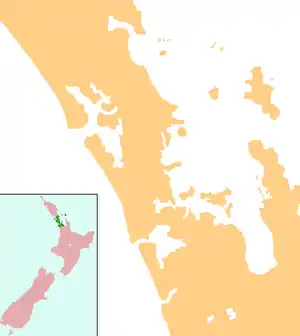Port Albert, New Zealand
Port Albert is situated on the shores of the Kaipara Harbour, approximately 8 kilometres west of Wellsford, in the Auckland Region of New Zealand.[1] Originally called Albertland, it was the last major European settlement in New Zealand.[2][3]
Port Albert | |
|---|---|
| Nickname(s): Albertland | |
 Port Albert | |
| Coordinates: 36.27°S 174.42°E | |
| Country | New Zealand |
| Region | Auckland Region |
The area has become known for its well draining soil, which has made it good farming and growing land.[4]
History
In 1861 William Rawson Brame, a Birmingham Baptist minister, founded the Albertland Special Settlement Association, organising non-conformist immigrants to come to New Zealand as part of the last organised British settlement in New Zealand. They included farmers, carpenters, servants, butchers, joiners, cabinetmakers, millers, drapers, sawyers, clerks and many other trades.[5][6]
The Albertlanders set sail for New Zealand on 29 May 1862, aboard numerous ships including the Matilda Wattenbach, Hanover and William Miles. The Matilda Wattenbach, which in some documents is referred to simply as the Matilda, made it to Auckland first on 8 September 1862, and the new settlers made their own way to the settlement of Albertland (now known as Port Albert).[2]
On 21 January 1862, a party set out from Auckland heading northward along the east coast in a whale boat. On board the boat were two Non-Conformist Settlement Associates, a provincial Surveyor and five men rowing the boat. The group landed late that afternoon at Wade (now Silverdale) where they stayed the night before setting off the next day on foot up the Waiwera Valley having to cross several creeks on the way. From there they set off by boat heading for the Puhoi river where there was a Maori settlement. This area of land would have been suitable for the Albertland settlement due to it covering both the west and east of the Island; however, the Maori had a claim to the water frontage of both sides of the island so landing would have been hard for the settlers. The explorers then surveyed a block just north of Helensville called the Komokoriki block. This block was so overgrown that the explorers struggled to walk through the dense bush and it would require too much work to bring it back to productive farming land. They then heard of the Oruawharo block on the Kaipara Harbour and decided to head back to Silverdale to get fresh supplies before attempting the five-day trek to this block.
After surveying the majority of the Okahukura Peninsula the explorers gained information from residents who lived on the Oruawharo River and decided to create the Albertland settlement a few kilometres up where there was good scrubland and bush with kauri for building,[5] using an Auckland Provincial Council scheme which "...provided 40 acres [16 hectares] each for a man and his wife, and 20 acres [8 ha] for each child between five and 18 years old – provided they paid their own fare and stayed on the land for five years, built a house, and began farming...".[7]
A sign at Port Albert concludes:
- More immigrant ships followed, but isolation and difficulties of access hindered progress and the original plans for a township at Port Albert were thwarted.[1]
References
- McClure, Margaret (5 August 2016). "Port Albert". Te Ara – the Encyclopedia of New Zealand. Retrieved 17 September 2018.
- Brett, Sir Henry; Hook, Henry (1979). The Albertlanders: Brave Pioneers of the 'Sixties. Christchurch: Capper Press.
- Herd, Louisa (2004). "The promised land". New Zealand Geographic.
- "Railway Earnings - A Ministerial Thunderbolt". Poverty Bay Herald. 10 June 1910. Retrieved 14 January 2011.
- Borrows, J.L. (1969). Albertland. A.H & A.W Reed. Auckland
- Brett, H., Hook, H.( 1929). The Albertlanders. Auckland New Zealand: The Brett Printing Company Limited.
- "The Land and People of Kaipara", Waitangi Tribunal